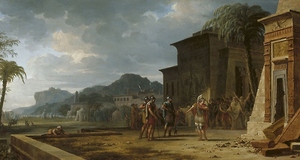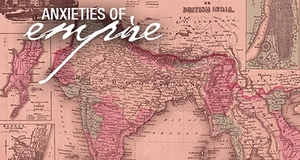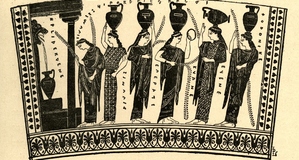Impressions of Ashoka in Ancient India
By
2009, Vol. 1 No. 11 | pg. 1/1 In the latter part of the third century B.C. India was rapidly changing. The Mauryan dynasty was expanding across the sub-continent of India and the line of kings which had begun with Chandragupta had lost another of its sons, Bindusara. Bindusara's son Ashoka was the next of the Mauryan kings. The small amount of land left to conquer, Kalinga, was soon taken by Ashoka and with it, the entire Indian sub-continent was made a part of the Mauryan dynasty. Ashoka had finished what Chandragupta had started so many decades earlier. The conquest of the Mauryans had reached its natural climax and Ashoka was now left to deal with managing this new mass of people, beliefs, and languages. Along with a conversion to Buddhism, Ashoka began to promote ideas of tolerance, respect, and good will, ideas that made up his Dhamma, instituted in order to help unify the empire. Many argue Ashoka's motivations for promoting the Dhamma were rooted in attempts to manipulate the empire by ascribing to a set of familiar values, while others cite Ashoka's known inscriptions as true testaments to his own strong moral fiber and honest beliefs. At a time when power would have been all too easy to abuse, Ashoka chose a different path, one that would seek to create a peaceful and tolerant India. Above all, Ashoka's motivations are that of a realist; Rather than ignore the contradiction created by Ashoka's conquering of Kalinga and subsequent disavowal of non-violent acts, I embrace both actions as the calculated decisions of a competent leader, interested only in the stability and value of the empire. Concerned first with completing the Mauryan legacy of empire creation, Ashoka then turned to a means of unification, specifically through a common set of values and beliefs present among many of the people of India at the time. Ashoka's primary duty was to the empire. Therefore, when Ashoka took over the empire following Bindusara's death his primary responsibility lay in conquering Kalinga and completing the Mauryan's conquest of the Indian subcontinent. Had Ashoka's concerns been only in spreading non-violence and tolerance of other people through his Dhamma then perhaps Kalinga would not have been targeted. Ashoka's decision to conquer Kalinga denotes a sense of duty to the empire, to the line of kings of the Mauryans. Ashoka's move does not seem to be that of a power hungry tyrant but rather a servant of the empire performing his understood duties. It could be argued that Ashoka merely did not promote his Dhamma at this point because he had not converted to Buddhism yet. However, Ashoka's conversion to Buddhism immediately following the conquering of Kalinga suggests it was part of a plan. “Now that the country of the Kalingas has been conquered, the Beloved of the Gods is devoted to an intense practice of the duties relating to Dharma.” (I-2 pg. 57)Ashoka does not dwell on the conquering of Kalinga in his rock edicts that would otherwise suggest a preoccupation with greed or malice towards others. Rather, Ashoka accepts the act and proceeds to apologize for the loss of life which was a result of the Kalinga conquest. “Verily the slaughter, death and deportation of men which take place in the course of the conquest of an unconquered country are now considered extremely painful.”(I-2 pg. 57) Apologizing for these transgressions might have served to calm tensions among not only those in Kalinga, but rather between all conquered people of the Mauryan dynasty. Ashoka's move towards benevolence and forgiveness so soon after conquering Kalinga seems convenient, yet convenience does not infer manipulation. Ashoka was keen on unifying the empire through the teachings of his Dhamma. Once Kalinga was conquered, Ashoka began to promote his Dhamma. Not specifically Buddhist ideas, these teachings and ideas were more in line with generally accepted moral values and beliefs held by the majority of the population. “Dhamma was aimed at building up an attitude of mind in which social responsibility, the behaviour of one person towards another, was considered of great relevance.”(RT pg. 86) This Dhamma was essential throughout the empire which was in a fragile state due to economic and social strains resulting from the new and vast empire. “It would seem that the people of the Mauryan empire required a focus or common perspective...and the result was his policy of Dhamma.”(RT pg. 86) Ashoka's decision to promote his Dhamma was not necessarily a feeling of duty arising from his own personal beliefs but merely the most effective solution at the problems that he faced. His actions were that of a realist seeking an answer to a problem. Ashoka's adherence to the Dhamma was extremely important, yet he was careful to not handcuff the dynasty. “That my sons and great-grandsons should not think of a fresh conquest by arms as worth achieving, that they should adopt the policy of forbearance and light punishment towards the vanquished even if they conquer a people by arms, and that they should regard the conquest through Dharma as the true conquest.” (I-2 pg. 59) Ashoka statement in this edict does not deny the possibility of future conquests. While he stresses avoiding the situations he concedes that if it must happen, it should justify the acts through promotion of the Dhamma. The contradiction seems obvious, yet it continues to evidence Ashoka's primary focus of maintaining and managing the Mauryan dynasty. Ashoka's proclamations and inscriptions were meant as pillars of tolerance in a fragile system. The rock edicts which Ashoka created were placed in public places written in local languages and placed throughout the empire, easy to see and understand by all. I believe these edicts would have attempted at creating a new tradition, based on Ashoka's Dhamma. Proclamations not only to those alive at the time, these edicts would serve as messages to all future generations. Some would argue that Ashoka was interested only in forcing his ideas on the people of the dynasty, yet his actions do not suggest those motivations. Instead, Ashoka was merely fulfilling the duties of his position. As king of a vast empire Ashoka's word was extremely powerful. Arguing that he was an aggressive idealist is hard. He had to make decisions and create some sort of system by which to manage the empire. He did what was necessary. If anything he should be lauded for ultimately supporting a system of tolerance and non-violence rather than tyrannical power. Yet in the end it was simply an effective means of managing a people. Ashoka's actions were answers to problems. The apparent juxtaposition of a king who kills in the thousands then preaches non-violence and tolerance is not hard to see. These actions which seem to oppose each other are Ashoka's answers to the changing reality that was India in the beginning of the third century B.C. Ashoka could not continue the rule as a conquering tyrant with no viable areas left to take over. Simultaneously, the fragile social and economic situation throughout was only made more fragile by the mix of conquered people now dealing with each other in a broader context. This clashing of beliefs and values required a unifying force which would promote those ideas that it needed to heed the most. Enter Ashoka's Dhamma. A set of values and beliefs rooted in the generalities of the religions of India which would promote non-violence and tolerance.
Sircar D.C., Inscriptions of Asoka. Ministry of Information & Broadcasting. Government of India: 2. Thapar, Romila. A History of India. Vol. 1. Clays Ltd. 1966 Suggested Reading from Inquiries Journal
Inquiries Journal provides undergraduate and graduate students around the world a platform for the wide dissemination of academic work over a range of core disciplines. Representing the work of students from hundreds of institutions around the globe, Inquiries Journal's large database of academic articles is completely free. Learn more | Blog | Submit Latest in History |


















